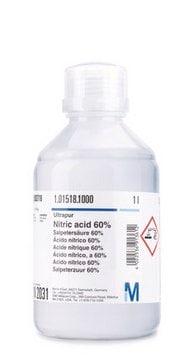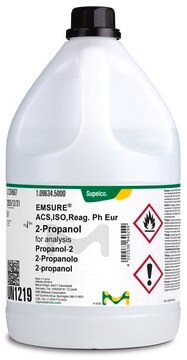TMS-011
Endotoxin-Free Ultra Pure Water
Cell Culture
Synonim(y):
H20
Zaloguj sięWyświetlanie cen organizacyjnych i kontraktowych
About This Item
Kod UNSPSC:
41116012
eCl@ss:
32160405
NACRES:
NA.71
Polecane produkty
Poziom jakości
Formularz
liquid
producent / nazwa handlowa
Chemicon®
metody
cell culture | mammalian: suitable
Powiązane kategorie
Opis ogólny
Endotoxin-Free Ultra Pure Water is sterile filtered through a 0.1 micron filter and is considered endotoxin-free (<0.005 EU/ml)
Zastosowanie
Endotoxin-free ultra pure water has been used in the purification of cationic lipid nanoparticles. It has also been used to purify graphite particles.
Jakość
Appearance: Clear Liquid/No Particulates
Sterility Testing: Negative for Growth
pH: 5.0-7.0
Endotoxin: <0.005 EU/mL
Sterility Testing: Negative for Growth
pH: 5.0-7.0
Endotoxin: <0.005 EU/mL
Przechowywanie i stabilność
Store at room temperature until expiration date.
Informacje prawne
CHEMICON is a registered trademark of Merck KGaA, Darmstadt, Germany
Oświadczenie o zrzeczeniu się odpowiedzialności
Unless otherwise stated in our catalog or other company documentation accompanying the product(s), our products are intended for research use only and are not to be used for any other purpose, which includes but is not limited to, unauthorized commercial uses, in vitro diagnostic uses, ex vivo or in vivo therapeutic uses or any type of consumption or application to humans or animals.
Ta strona może zawierać tekst przetłumaczony maszynowo.
Kod klasy składowania
10 - Combustible liquids
Klasa zagrożenia wodnego (WGK)
nwg
Temperatura zapłonu (°F)
No data available
Temperatura zapłonu (°C)
No data available
Certyfikaty analizy (CoA)
Poszukaj Certyfikaty analizy (CoA), wpisując numer partii/serii produktów. Numery serii i partii można znaleźć na etykiecie produktu po słowach „seria” lub „partia”.
Masz już ten produkt?
Dokumenty związane z niedawno zakupionymi produktami zostały zamieszczone w Bibliotece dokumentów.
Klienci oglądali również te produkty
Fatima Alnasser et al.
Nano letters, 19(2), 1260-1268 (2019-01-11)
The biological interactions of graphene have been extensively investigated over the last 10 years. However, very little is known about graphene interactions with the cell surface and how the graphene internalization process is driven and mediated by specific recognition sites
Daniel Helman et al.
Cytometry. Part A : the journal of the International Society for Analytical Cytology, 85(2), 162-168 (2013-06-15)
We developed a membrane bound reporter and selection molecule for sorting by fluorescence activated cell sorting (FACS) of cells producing a protein of interest. This molecule is composed of a transmembrane (TM) domain, fused on its extracellular end to a
Nasz zespół naukowców ma doświadczenie we wszystkich obszarach badań, w tym w naukach przyrodniczych, materiałoznawstwie, syntezie chemicznej, chromatografii, analityce i wielu innych dziedzinach.
Skontaktuj się z zespołem ds. pomocy technicznej



